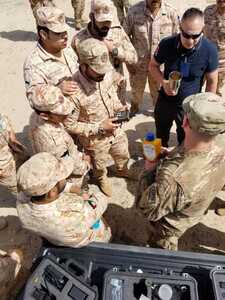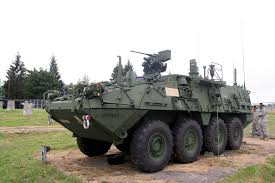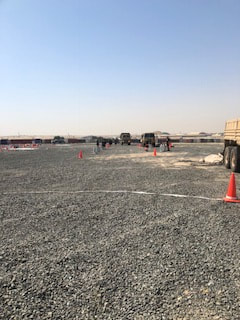|
OSHA Standard: 1926.300 – Subpart I – Tools – Hand & Power
Training: Training should be performed upon initial assignment/before use of tool. Frequency: When roles, conditions, or equipment changes. Or when worker is using the equipment in an unsafe manner. 1. Always place the load well forward, balanced and confined in size for safety. The load should clear safely through openings, aisles and roadways. The user should be able to see over and around the load to guide it safely. The load should be secured, or held steady, against shifting or falling. 2. When picking up a wheelbarrow, spare your back by giving your legs their fair share of the lifting. Bend the legs for lifting instead of bending the back. Spare your back and the wheelbarrow by never overloading. 3. Always push a loaded wheelbarrow forward. This is the way to avoid being run over. Warn others out of the way. A walking pace is safer than running. 4. Cross over obstacles at the right angle, especially over rails or planks which may divert the wheel causing the load to spill or fall. 5. The wheelbarrow wheel or wheels should be inspected and maintained regularly. Maintain proper lubrication according to directions. Inspect tires for damage. Keep tires inflated according to directions. Keep all bolts and fittings tight and secure. 6. Wheelbarrow handles are for your hands. Replace handles which are split or splintered. Use handle guards to protect your knuckles from scrapes, cuts and fractures. 7. A wheelbarrow by itself will not harm you or anyone else. You are responsible for how well a wheelbarrow is handled, operated, maintained and stored for safety.
0 Comments
The Associated Builders and Contractors, Inc. (ABC) recently released their 2019 Safety Performance Report boasting a drastic reduction in the number of OSHA recordable incidents for companies involved in their ABC STEP program. The average company involved in this program showed nearly a 200% safer Total Recordable Incident Rate (TRIR) than the industry average while companies recognized as a Diamond participant showed a nearly 680% safer TRIR. What attributed to such a drastic shift for companies involved in the STEP program? ABC says a commitment from leadership, a shift in company culture from the beginning and acting on eight core leading indicators are the leading factors.
High Scoring companies in the STEP Program with engagement from c-suite management showed over a 60% decrease in the TRIR and DART (Days Away, Restricted, or Transferred) rate compared to those with no engagement from upper management. The same type of reduction (over 50%) was shown when companies committed to a safety culture, including an in-depth new hire orientation that introduced the company’s values, expectations and procedures. The eight core leading indicators contributing to the rate reductions included toolbox talks, substance abuse programs, performance reviews, action on indicators, safety meetings, PPE requirements, safety pre-planning and goal setting. Each one of these indicators being implemented into the company culture showed decreases between 50%-60% of the company’s TRIR and DART rates. If these steps being implemented can have such a huge impact on company safety records, why isn’t everyone doing it? The simplest answer is time and money. Many companies are either unwilling or unable to provide these types of changes to their company culture. The 2018 Training Survey conducted by Safety+Health showed that 70% of companies spent less than $500 per individual on safety training. Of all companies surveyed nearly 1 in 4 spend less than $5,000 for safety training for their entire company. When asked of the five hardest challenges regarding safety training, two of the top answers were “Finding Time to Train Workers” and “Lack of Support From Leadership”. While many of these companies struggle with changing the culture from the top down, almost all agree that safety training should be conducted to help reduce injuries and illnesses. It may be difficult to change a company’s culture overnight but implementing change to a safety-oriented culture must start somewhere. With three people being fatally injured during every workday, the construction industry must strive for the goal of zero accidents. While STAC may not be able to change the mindset from the c-suite management, we can help change some of the core leading indicators to impact safety performance. Whether it’s helping collect toolbox talks, storing substance abuse programs, or tracking indicators and incidents for review, STAC is dedicated to providing service with the peace of mind and affordability for companies of varying sizes. We provide real time access to information helping those already pressed for time focus on keeping their people safe while changing the culture in which they work. Committing to compliance could change lives, while committing to safety within your culture will save them. Kuwait Army Training I got the opportunity to train with my counterparts in the Kuwait Army Weapons of Mass Destruction (WMD) Corps. The Kuwaiti’s trained us on there area reconnaissance tactics and we trained them in our site characterization, exploitation, and mounted reconnaissance. We were able to facilitate this training with the use of translators. I was more comfortable than others with speaking through a translator with previous trainings in safety, except I was more used to English to Spanish, not English to Arabic. Regardless of that, it was a great relationship building exercise and fostered a real sense of partnership. It was great to talk with the guys during the break, it really shows that wherever you go, people are generally the same. It will be an experience that I will not forget. Kuwait Towers My most recent trip off Camp Arifjan was to the Kuwait Towers. The Kuwait Tower park is located in Kuwait City standing prominently into the Persian Gulf. The park consists of three towers with the largest tower standing at 614 feet and carries two spheres within the tower, which contains an observation post of the entire city and the Persian Gulf. These towers are actually water towers and there are 31 other towers spread throughout Kuwait, although they are not as large or prominent as the 3 Kuwait Towers. The city is just as lavish and modern as any other American city. Cross Training: This past month my unit conducted cross level training. My platoon specializes in dismounted reconnaissance (in which we perform site characteristics to gather intelligence to send back to higher). The other two main focuses are mounted reconnaissance with Strykers and decontamination. The mounted reconnaissance vehicle is the Stryker, which is essentially an armored personnel vehicle. The variation of the Stryker combat vehicle that we have is the M1135 Nuclear Biological, Chemical Reconnaissance Vehicle (NBCRV). This variation of the Stryker has an on-board integrated NBC sensor suite. Driving the Stryker is actually very fun, the driver seat is low to the ground, it’s almost like driving a sports car, that cost several million dollars. The NBCRV has a complement of 4 soldiers (driver, surveyor, vehicle commander, and assistant). The NBCRV has a left handed glove port on the back of the vehicle. The surveyor has to lay on the floor, use the glove port, and attempt to look outside the window (which is a little bit smaller than a piece of paper) to collect samples. It is an extremely difficult task and takes lots of practice to get used to. You literally only have your left hand to work with. The other cross level training we did was in decontamination principles. The decontamination platoon taught us about mass casualty decon, equipment decon, and terrain decon. The problem with the training is wearing the appropriate protection level and dealing with the heat. Other than that, it was good to learn these tasks as it will be the main task that we will be doing once we get back to Ohio. Heat: Being from Ohio, I am used to a more humid summer weather. The heat here is more of a “dry heat,” but there is still a decent amount of humidity in the air. Just walking outside during the daytime makes me sweat. Even at 2100 the temperatures can be in the 90s. The “coolest” the daytime temperature in the next two weeks will be 96 degrees Fahrenheit, with most days being consistently over 100 degrees Fahrenheit. By 0500 the sun is up, and the temperatures can already be in the 80s. The weather honestly feels like opening the door of an oven. It is very windy, and the wind just blows more hot air into your face. The crazy part, we haven’t even reached the hottest time of the year in July/August in which the temperatures will be between 110-120. Family:
Jane is now almost 10 months old and was able to go in the pool for the first time this season. She is a water baby, and that should make her mother happy. I have well over 1,000 photos and videos on her on my phone. As a follow up to Safety Week, the importance of safety and training is at the top of the list for most safety-oriented people. With an increased commitment to safety training, New York City’s Department of Buildings will begin to enforce Local Law 196 of 2017 starting in December of this year. As part of a response from an increase in construction related fatalities a few years ago, the New York City council passed LL 196 to require contractors to have a much higher commitment to safety training to work inside the city. As the law will continue to be phased in over the next year, all workers at commercial construction jobsites will be required to have 40 hours of safety training and all supervisors will require 62 hours of safety training. In addition, all workers will be required to have a Site Safety Training (SST) Card. This card is to provide access to an online verification system, dates of course completion and expiration, a unique identification card number, photographs of the person to whom it was issued, and the printed name of the signature of the card holder. So what training is needed? Worker Required Training:
Supervisor Required Training:
Renewal Training:
How long does this training last? The SST card is valid for 5 years before a renewal is required. Within the one-year period prior to renewal application, each worker is to take a 4-Hour Fall Protection and 4-Hour Supported Scaffold User training class. All supervisors are required to take 8-Hour Fall Prevention, 4-Hour Supported Scaffold, 2-Hour Toolbox Talks and 2-Hour Pre-Task Safety Meetings training courses. All training must be done in person or an actively proctored online training. Enforcement: What happens if you don’t live up to the new standard? Well the worker, employer and owner of the project can all be fined up to $5,000 per untrained worker. In addition, each permit holder is required to maintain the BC3321.2 Log which maintains the information of all trained workers and their SST Cards or be fined $2,500 per occurrence. Safety and safety training should be an integral part of every company culture, especially in construction. Tracking and documenting that training is an important component in addition to providing the training because if there is no proof, it did not happen in most people’s eyes. Since we are all forgetful and busy people, refreshing training should be a routine part of your company’s culture as well. Although, not every city or state will go as far as NYC, it is important to reinforce the need and commitment to safety within a company and community. As a commitment to this ideology STAC will also be introducing the new STAC Safe Badge to companies that show an increased commitment to safety training. More to come, stay tuned. OSHA Standard: 1926.300 – Subpart I – Tools – Hand & Power Training: Training should be performed upon initial assignment/before use of tool. Frequency: When roles, conditions, or equipment changes. Or when worker is using the equipment in an unsafe manner. Background: Power Tools include: Electric, pneumatic, liquid fuel, power-actuated, and hydraulic power tools. Employees who use power tools and are exposed to the hazards of falling, flying, abrasive, and splashing objects, or to harmful dusts, fumes, mists, vapors, or gases must be provided with the appropriate personal protective equipment. Employees should be trained in the proper use of all tools. Workers should be able to recognize the hazards associated with the different types of tools and the safety precautions necessary. Five basic safety rules can help prevent hazards associated with the use of hand and power tools: Power tools must be fitted with guards and safety switches; they are extremely hazardous when used improperly. The types of power tools are determined by their power source: electric, pneumatic, liquid fuel, hydraulic, and powder-actuated. To prevent hazards associated with the use of power tools, workers should observe the following general precautions:
Employer Requirements: The employer is responsible for the safe condition of tools and equipment used by employees. Employers shall not issue or permit the use of unsafe hand tools. Employees should be trained in the proper use and handling of tools and equipment. Appropriate personal protective equipment such as safety goggles and gloves must be worn to protect against hazards that may be encountered while using hand tools. Workplace floors shall be kept as clean and dry as possible to prevent accidental slips with or around dangerous hand tools. Employee Requirements: Employees, when using saw blades, knives, or other tools, should direct the tools away from aisle areas and away from other employees working in close proximity. Knives and scissors must be sharp; dull tools can cause more hazards than sharp ones. Cracked saw blades must be removed from service. Take Home Points: Both employer and employee have responsibility in ensuring safety while operating hand tools. Ensure that the tool is maintained and inspected, use the right tool for the right job, follow manufacturers’ guidelines, ensure the workplace is safe for use of the tool, and wear the appropriate PPE. OSHA Standard: 1926.300 – Subpart I – Tools – Hand & Power
Training: Training should be performed upon initial assignment/before use of tool. Frequency: When roles, conditions, or equipment changes. Or when worker is using the equipment in an unsafe manner. Powder-Actuated Tools Powder-actuated tools operate like a loaded gun and must be treated with extreme caution. In fact, they are so dangerous that they must be operated only by specially trained employees. When using powder-actuated tools, an employee must wear suitable ear, eye, and face protection. The user must select a powder level—high or low velocity—that is appropriate for the powder-actuated tool and necessary to do the work without excessive force. The muzzle end of the tool must have a protective shield or guard centered perpendicular to and concentric with the barrel to confine any fragments or particles that are projected when the tool is fired. A tool containing a high-velocity load must be designed not to fire unless it has this kind of safety device. To prevent the tool from firing accidentally, two separate motions are required for firing. The first motion is to bring the tool into the firing position, and the second motion is to pull the trigger. The tool must not be able to operate until it is pressed against the work surface with a force of at least 5 pounds (2.2 kg) greater than the total weight of the tool. If a powder-actuated tool misfires, the user must hold the tool in the operating position for at least 30 seconds before trying to fire it again. If it still will not fire, the user must hold the tool in the operating position for another 30 seconds and then carefully remove the load in accordance with the manufacturer’s instructions. This procedure will make the faulty cartridge less likely to explode. The bad cartridge should then be put in water immediately after removal. If the tool develops a defect during use, it should be tagged and must be taken out of service immediately until it is properly repaired. Safety precautions that must be followed when using powder-actuated tools include the following:
When using powder-actuated tools to apply fasteners, several additional procedures must be followed:
Take Home Points: Both employer and employee have responsibility in ensuring safety while operating hand tools. Ensure that the tool is maintained and inspected, use the right tool for the right job, follow manufacturers’ guidelines, ensure the workplace is safe for use of the tool, and wear the appropriate PPE. |
AuthorSTAC Admin Categories
All
Archives
July 2024
|



















 RSS Feed
RSS Feed